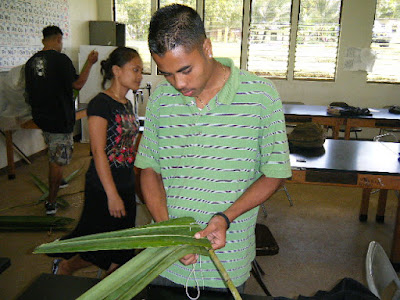Thatching
The SC/SS 115 Ethnobotany class taught each other thatching. This term the class used Nipa fruticans. In previous terms the class used the traditional material for Pohnpeian thatching, Metroxylon amicarum, but this requires cutting down the tree to access the fronds. Nipa fruticans can be obtained non-destructively from the plant.
Iumileen sews doakoahs en Pohnpei. There are two styles of Pohnpeian thatching, doakoahs en Ruk and doakoahs en Pohnpei or simply doakoahs. Doak means "to pierce" with a needle-like object. Oahs is the Pohnpeian name for Metroxylon amicarum.
On Pohnpei in the past the tip of a marlin (a bill fish) was used as a needle. Today the sharpened end of a toothbrush with a hole in the end is a good needle, nails are also sometimes used. Nails with heads, however, do more damage to the frondlet due to their heads. Iumileen was working with a whittled piece of bamboo.
Piulyn assists Marsela. Note that the frondlets are folded so as to create a one-third, two-thirds split in relation to the length of the frondlet. The base is one-third, the apical end is two-thirds. The minor rafters over which the frondlets are folded are made of either Phragmites karka (Chuuk: Woowo, niwo, Kosraen: loa, Pohnpeian: lirau) or Saccharum spontaneum (Kosraen: ac, Pohnpeian: ahlek). The minor rafters are called rahu in Pohnpeian. Today we used ahlek. Marsela is sewing using a needle also made from ahlek.
Fritzgerald attempts doakoahs en Pohnpei, but the parem is too narrow to produce proper doakoahs. Doakoahs en Pohnpei differs in being laid on a 45 degree diagonal. Note that traditionally Pohnpeian thatch was not covered by a net to protect the roof from wind damage.On the flat, outer island atolls in mid-ocean the wind is a more significant source of damage. On Pohnpei rain and subsequent thatch rot are apparently more problematic. Pohnpei thatch is not netted down. The thatch is designed to catch the wind and "fluff" slightly, aiding in drying of the thatch and slowing rot.
Piulyn removes the nohk - the back half of the midrib. This is necessary when using oahs due to the thick midrib. The oahs frondlet cracks and breaks unless this is done. This is not apparently strictly necessary with parem. The nohk from oahs are then used to make a whisk broom.
Senioleen uses her teeth to crack the midrib and split the nohk.
Kosrae does not have oahs. Kosrae is presently thought to have only four species of palms. Coconut (Cocos nucifera), betel nut (Areca catechu), Ponapea ledermanianna (Kosrae: kitacr, Pohnpei: kedei) , and Nipa fruticans. On Kosrae Nipa fruticans is used for thatch (Kosrae: fahsuc, Pohnpei: parem). Fahsuc is narrower than oahs. Thatching frondlets are laid down in pairs and folded at the midpoint.
In Chuuk pandanus is used for thatch, as well as coconut palm leaf. Coconut palm leaf has a reputation for a short life span across Micronesia.
Linguistic note: dok is "pierce" while oahs refers to Metroxylon amicarum. The combining of the words is what is known in linguistics as verb noun incorporation or incorporated objects. When the word is by itself, it is dok (intransitive), which means to pierce or to stab. The transitive form of it on the other hand is doakoa. The use of /oa/ is sometimes /o/, depending on the following vowel or consonant sounds. For instance, doakoahs, to pierce oahs, dokpwihk, literally to stab a pig (to pig-slaughter), dokomwomw, to spearfish,etc. [Source: Robert Andreas]









Comments
Post a Comment